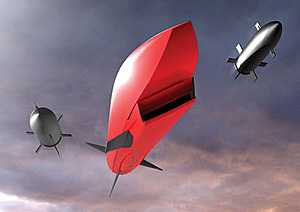Perseus (missile)
| CVS401 Perseus | |
|---|---|
|
An artist's depiction of the Perseus supersonic multi-role cruise missile. Along side it are its two effectors which have been released from the lateral bays of the parent missile. | |
| Type | Multi-platform launched anti-ship & land-attack Supersonic cruise missile |
| Place of origin | France/United Kingdom |
| Production history | |
| Manufacturer | MBDA |
| Specifications | |
| Weight | 800kg |
| Length | 5m |
| Warhead | A 200kg main warhead with an additional 2 x 40–50kg inertially guided effectors from lateral bays. |
|
| |
| Engine | A continuous detonation wave engine (CDWE) Ramjet motor. |
Operational range | 300km class |
| Flight altitude | Two types of attack profile are envisaged: A high-altitude approach, or a Sea-skimming low-altitude approach followed by a pop-up. |
| Speed | Mach 3 (3,675 km/h; 2,284 mph; 1.0209 km/s) |
Guidance system | A multimode active e-scan radar and a laser radar. Also features a semi-active laser guidance capability. |
Launch platform | Ship, submarine or aircraft. |
Perseus or CVS401 Perseus - named after the hero Perseus (Greek: Περσεύς) from Greek mythology - is a stealth supersonic cruise missile currently under development by MBDA in consultation with the Royal Navy and French Navy.[1] The weapon was first unveiled at the 2011 Paris Air Show.[2][3] CVS401 Perseus is primarily a supersonic surface-launched and submarine-launched cruise missile built around an advanced, agile and stealth aircraft airframe.[4] It is initially intended to replace the French and British anti-ship missiles currently in service with the Royal Navy and Marine Nationale (Harpoon and Exocet).
With further weapon system integration, Perseus is also expected to eventually replace MBDA's Storm Shadow air-launched land-attack cruise missiles currently in service with the Royal Air Force and French Air Force.[5]
Characteristics
MBDA describes the missile as a "Unique multi-role, multi-Platform weapon system" to be integrated on all major weapon platforms such as; warships, submarines, aircraft and land-based platforms.[6]
The stealthy Perseus missile is planned to have a range of 300 km reaching speeds of Mach 3. It is powered by a ramjet motor, built around a highly compact Continuous Detonation Wave Engine (CDWE). The missile is 5 metres in length and weighs around 800 kg, with a 200 kg "main" warhead. In addition to the main warhead, Perseus is equipped with 2x 40–50 kg inertially guided effectors (submunitions) from lateral bays which can be released before the missile hits its target. This unique feature allows Perseus to strike either a multitude of targets in the same area, or to strike a singular large target - such as an Aircraft carrier - in several different areas at once for maximum destruction. "In this case, a linear attack pattern could be selected, munitions striking the forward, centre and aft sections simultaneously. If a unitary blast is required, then the effectors remain on board the parent missile to add their blast effect to the central warhead."[1]
Two types of attack profiles are envisaged: A high-altitude approach, for engaging land based targets and a Sea-skimming low-altitude approach followed by a pop-up maneuver for engaging surface threats like enemy warships.[1] The missiles "skimming the sea at wave top" followed by a pop-up maneuver would only allow an estimated 3 second response time for enemy warships.[3]
The missiles sensor suite includes;
- A multi-mode active e-scan radar with synthetic aperture radar and Doppler beam sharpening.
- A laser radar (lidar) for terminal phase imaging and target recognition.
The missile also features a "semi-active laser guidance capability." MBDA believes that this guidance method will remain important for time-sensitive targeting for many years to come. Satellite datalink is to be incorporated for "in-flight re-targeting, using thin-profile, low-observable active antenna arrays."[1]
The missile will be VLS launched and is compatible with the American Mark 41 Vertical Launching System and the French A70 Sylver Vertical Launching System.[6] The missile may eventually equip the Royal Navys future Global Combat Ship.
Potential operators
See also
- YJ-12 - A Chinese supersonic anti-ship missile.
- P-800 Oniks - A Russian supersonic anti-ship missile.
- BrahMos - An Indo-Russian supersonic anti-ship missile.
References
External links
| ||||||||||||||||||||||
